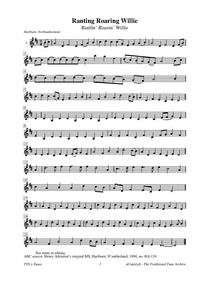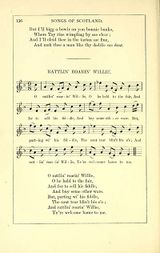Template:Pagina principale/Vetrina: Difference between revisions
No edit summary |
No edit summary |
||
| Line 1: | Line 1: | ||
{{SheetMusic | {{SheetMusic | ||
|f_track= | |f_track=Rattlin Roarin Willie.mp3 | ||
|f_pdf= | |f_pdf=Ranting Roaring Willie.pdf | ||
|f_artwork= | |f_artwork=Rattlin Roaring Willie.jpg | ||
|f_tune_name= | |f_tune_name=Rantin' Roarin' Willie | ||
|f_track_title= | |f_track_title=Rantin'_Roarin'_Willie_(1) | ||
|f_section=abc | |f_section=abc | ||
|f_played_by=[https://soundcloud.com/ | |f_played_by=[https://soundcloud.com/danny-mcnab-93215924 Danny Mc Nab] | ||
|f_notes= | |f_notes= Glen Collection of printed music: Songs of Scotland prior to Burns. | ||
|f_caption= | |f_caption=The song is a description of the adventures of a whirligig maker or wood turner in the pursuit of a runaway galloway or pony, and the ingenious way in which the names of the different localities are interwoven with the story reveal a marvelous command of the rhyming faculty. | ||
|f_source=[https://soundcloud.com/ | |f_source=[https://soundcloud.com/danny-mcnab-93215924/rattlin-roaring-willie-bon Soundcloud] | ||
|f_pix=420 | |f_pix=420 | ||
|f_picpix=200 | |f_picpix=200 | ||
|f_article=[[ | |f_article=[[Rantin'_Roarin'_Willie_(1) | '''Rantin' Roarin' Willie''']] | ||
'''Old and New Edinburgh, vol. 2''' (p. 55) gives that Burns’ poem was inspired by a member of the Crochallan Fencibles, a convivial society in Edinburgh that met at Dawney Douglas’s tavern, to which Burns was introduced in 1787. The member’s name was Wiliam Dunbar, W.S., and he was the “Colonel” of the club and a predominant wit. A different tale has it that Rattlin' Willie was a wandering fiddler famous as both a musician and as a brawler in the Jedburgh (Jeddart) area, whose "sword-hand was dreaded as much as his bowing arm was admired". He fell out with another fiddler named Robin Rool (Robin of Rule Water) after an argument over their respective musical abilities and in the fight that ensued Robin was killed. His death was avenged at the hands of two of the Elliots, who in turn slew Willie. Scott alludes to Rattlin' Roarin' Willie (described as “the jovial harper”) in his The Lay of the Last Minstrel, noting that he was a real person. Other accounts say that Willie, still a ‘rantin’, roarin’ lad, lived in the 17th century and did business in the Hawick and Langholm districts, until, having had the misfortune to murder a brother in trade who passed by the name of 'Sweet Milk', he was executed at Jedburgh. Neil (1991) quotes the following verse: | |||
<blockquote> | <blockquote> | ||
''The | ''The Lasses of Ousenam Water''<br> | ||
''the | ''Are rugging and riving their hair,''<br> | ||
'' | ''And a' for the sake O' Willie—''<br> | ||
'' | ''They'll hear his sangs nae mair,''<br> | ||
'' | ''Nae mair to his merry fiddle''<br> | ||
'' | ''Dance Teviot's maidens free;''<br> | ||
'' | ''My curses on their cunning''<br> | ||
''That gar'd sweet Willie dee!''<br> | |||
</blockquote> | </blockquote> | ||
}} | }} | ||
Revision as of 07:55, 27 May 2023

Played by: Danny Mc Nab
Source: Soundcloud
Image: Glen Collection of printed music: Songs of Scotland prior to Burns.

Old and New Edinburgh, vol. 2 (p. 55) gives that Burns’ poem was inspired by a member of the Crochallan Fencibles, a convivial society in Edinburgh that met at Dawney Douglas’s tavern, to which Burns was introduced in 1787. The member’s name was Wiliam Dunbar, W.S., and he was the “Colonel” of the club and a predominant wit. A different tale has it that Rattlin' Willie was a wandering fiddler famous as both a musician and as a brawler in the Jedburgh (Jeddart) area, whose "sword-hand was dreaded as much as his bowing arm was admired". He fell out with another fiddler named Robin Rool (Robin of Rule Water) after an argument over their respective musical abilities and in the fight that ensued Robin was killed. His death was avenged at the hands of two of the Elliots, who in turn slew Willie. Scott alludes to Rattlin' Roarin' Willie (described as “the jovial harper”) in his The Lay of the Last Minstrel, noting that he was a real person. Other accounts say that Willie, still a ‘rantin’, roarin’ lad, lived in the 17th century and did business in the Hawick and Langholm districts, until, having had the misfortune to murder a brother in trade who passed by the name of 'Sweet Milk', he was executed at Jedburgh. Neil (1991) quotes the following verse:
The Lasses of Ousenam Water
Are rugging and riving their hair,
And a' for the sake O' Willie—
They'll hear his sangs nae mair,
Nae mair to his merry fiddle
Dance Teviot's maidens free;
My curses on their cunning
That gar'd sweet Willie dee!
...more at: Rantin' Roarin' Willie - full Score(s) and Annotations
X:1 T:Ranting Roaring Willie [1] T:Rattlin' Roarin' Willie M:9/4 L:1/4 S:Henry Atkinson's original MS, Hartburn, N'umberland, 1694, no. HA.134 O:England A:Hartburn, Northumberland N:"Unedited". Many inconsistencies in the MS, but I have refrained from editing N:as it is a tune commonly found elsewhere. CGP N:See Matt Seattle's reconstruction http://www.folknortheast.com/learn/core-tunes/rattlin-roarin-willie H:1/4 Z:vmp.Chris Partington, Jan. 2004 K:D V:1 clef=treble name="1." [V:1] (B/c/)|A2D F2D (FA)B|cdc (cG)EG(AB)|A2D F2D (F/A/) |(B/c/) (d/c/)(d/c/)(d/c/)”^sic barlines”| (d/c/)(B/A/)(G/F/) A2(B/c/)|(d/c/)(d/c/)(d/c/) (d/c/)(B/A/) (G/F/) A2B|cdc (c/G/)E GAB|A2F B2A d2(c/B/)| ADF ECE D2||D|DA,D DA,D DA,D|EDE CEC (E/F/G)E|EA,D DA,D DA,D|FEF CFC F/G/AF| EDE CEC (E/F/)GE|A2F B2A d2(c/B/)| ADF ECE D2||A|d>ef f>ef d2A|c>de e>de c2A| cAB Adc/B/|A/D/F E/C/ED2||A|AFD AFD AFD|cGE cGE cGE|AFD AFD| dAF dAF dAF|dAF dAF dAF|cGE cGE G>AB|A2F B2A dc/B/| ADF FCE D3-|D2|] W:See notes re editing
